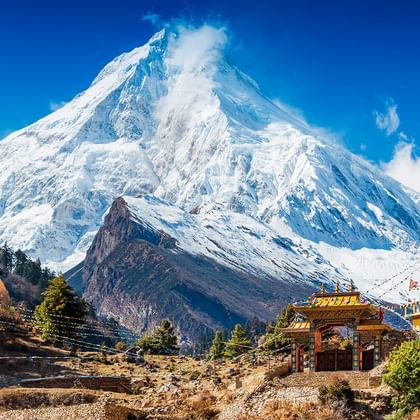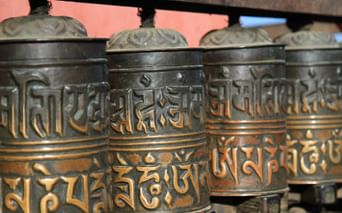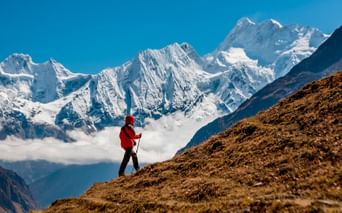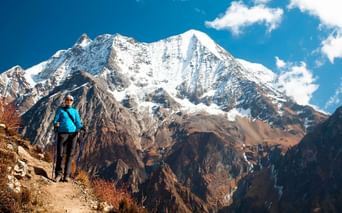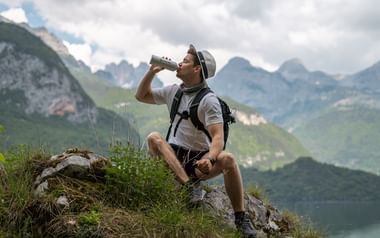Free cancellation up to 35 days before departure
This tour is covered by our special free cancellation policy up to 35 days before departure.
Itinerary
Upon arrival in Kathmandu, you'll be met at the airport by your guide and driven through the vibrant city to your hotel, centrally located in the charming neighbourhood of Thamel. Enjoy the rest of the day at leisure to stroll through the narrow streets of Thamel and browse the shopping opportunities and equipment shops, or perhaps grab a coffee at one of the many cosy cafés.
Hotel (example): Kathmandu Garden Home
Today there is a guided tour to two famous temples. The Hindu Pasupatinath and the Buddhist Buddhnanath. You'll be met in the morning by a local guide and after a delicious breakfast you'll be shown around the city. The Hindu temple of Pasupatinath, dedicated to the god Shiva, is located on the banks of the sacred Bagmati River. Built in pagoda style with beautifully carved silver doors, it is one of the holiest temples in Hindu culture. Pasupatinath Temple is the destination for Hindu pilgrims from all over the world during Shivartri. Only Hindus are allowed to enter the central courtyard of the temple. Tourists are ‘content’ to view the temple from the opposite bank of the Bagmati River.
Next is the Buddhist temple of Bouddhanth, which is the largest Stupa (Buddhist earthen mound) in South Asia and the centre of Buddhism in Nepal. The ancient and colossal Stupa was built in the 6th century by King Man Dab of the Lichhabi dynasty. The stupa rests on three large terraces and from above it takes the shape of a lotus flower, which is a very sacred flower for Buddhists around the world.
Accommodation: 3-star hotel
Guided tour: approx. 4-5 hours
Hotel (example): Kathmandu Garden Home
After an early breakfast, we head by car to Machha khola, the entrance to the Manaslu trek. The drive on the Nepalese highways goes through the central mountains of Nepal and offers stunning landscape views. You'll also pass several small towns and villages where you'll get a glimpse of rural life in Nepal. The tour continues along the beautiful River Trishuli towards Machha khola via Arughat Bazar.
Drive: The journey takes 8-9 hours.
Hotel (example): Teahouse
As the valley slopes become steeper, the cultivated landscape ceases and only a few fields remain on the valley sides. You follow the river, which winds its way through some steep cliffs, to the hot springs of Tatopani. There are several small villages in this part of the valley that are inhabited by the Gurung people and their religion is Hinduism. It's a spectacular area you walk through, with waterfalls and swinging suspension bridges spanning the rushing river. Mid-afternoon you'll hike into Jagat, 1,410m.
Jagat is an interesting small town with its characteristic houses. The town serves as a trading centre for the surrounding valleys and has many small shops, a small health centre, a police checkpoint and a national park office.
Hotel (example): Teahouse
Today's destination is Philim. After leaving Jagat, you'll trek towards Salleri Village. Weather permitting, you'll be able to experience stunning views of the Sringi Himal during the trek. After crossing Salleri, the route heads steeply up and down the mountain trail to the peaceful village of Sirdibas. To get from Sirdibas, a suspension bridge has to be crossed and then the trail climbs steeply towards Philim (1590 metres).
Hotel (example): Teahouse
The day is a 6-hour trek from Philim to Bihi. The first part of the trek passes through a relatively flat landscape at Ekle Bhatti and then descends downhill towards the intersection of two trekking routes - Tsum Valley trek and Manaslu Circuit Trek. From here you continue (via the Manusla route) past the villages of Nyak and Deng, after which the route climbs steeply to today's destination, Bihi (2,130 metres).
Hotel (example): Teahouse
Enjoy the beautiful views from Bihi over the Kutang Himal before the 6-hour trek to Namrung village begins. Today's route leads through an area with a distinctly Buddhist flavour. You'll see Mani walls, Chhortens and prayer flags along the way. After passing Ghap village, it's not far to your destination, Namrung village (2670 metres).
Hotel (example): Teahouse
During today's relatively short 4-hour trek to Lho village, you'll pass an altitude of over 3000 metres for the first time. The trek starts early in the morning from Namrung towards Lihi village, which offers beautiful views of Sinmang Himal and Naike Peak. From here the route climbs steeply towards Shyo. As compensation for the tough uphill trek, you can take comfort in the fact that the views gradually become more and more spectacular. Today's trek ends in the Lho countryside (3,180 metres), where you'll spend the night.
Hotel (example): Teahouse
After breakfast, you start trekking along a descending trail. Once you reach Shyala, the trail begins to ascend. Along the way, you'll experience breathtaking views of mountains and beautiful landscapes. You will now pass the isolated Nubri Valley. Samagaun will be your destination for the day. After lunch, explore Birendra Tal (Lake), which is the lake formed by the glacier of the Manasalu Mountains. You will have time to explore the beautiful village where the ethnic Nubri people practice Tibetan culture and Buddhism.
Hotel (example): Teahouse
This day is set aside for acclimatisation purposes. You can trek to Manasalu Basecamp - 4 hours up and 2.5 hours down. The trail has steep climbs, a rocky path and some sections of loose slope, so the route is quite demanding. You will experience great views of Samdo (Pang Phuchuli); Nagdi Chuli, Simnang Himal, Manaslu and Mansalu Glacier/Manaslu Icefall. Alternatively, you can visit Pugen Gumpa (Buddhist monastery) - 3 hours up and 2 hours down. If you choose this monastery, it's usually closed, so you'll just be looking at it from the outside. Moreover, the best views of the Manasalu and Nagdi Chuli mountains can be seen.
Hotel (example): Teahouse
After a day of relaxation in Samagaun, the journey continues towards Samdo. The trek starts early in the day, passing Karmo Kharka and continuing towards Samdo. Along the way, you'll see yaks and donkey trains transporting goods to and from neighbouring areas. When you reach Samdo (3,860m), after about 5 hours of trekking, you'll enjoy views of Samdo Peak and Pangboche Himal Stay.
Hotel (example): Teahouse
Today the trek goes to Dharamsala, also known as Larke Phedi. This is the base of the famous Larkya La pass. The approximately 5-hour trek takes you through barren but beautiful terrain that offers stunning views of the snow-capped mountains. From here you will be able to see the north side of Mount Manaslu. You'll spend the night in Dharamshala (4,460 metres).
Hotel (example): Tea House
Today is the highlight of the trek - both literally and figuratively. Along the way, you'll cross the Larkya La Pass - the highest point of the trek at 5,160 metres above sea level. The trek starts early in the morning from Dharamsala and leads up winding mountain trails with irresistibly beautiful mountain views. At the Larkya La pass (known as ‘Victory Hill’) you can see the peaks of Himlung Himal, Gyaji Kang, Pang Phuchi, Annapurna II, Kang Guru, Namjung Himal and many other mountains.
After enjoying the picturesque views from Larkya La, the trek heads downhill. The first downhill section is relatively easy, but after about 30 minutes it starts to get extremely steep, so it's important to be extremely careful. The steep route and the small breaks to take in the mountain views mean it can take up to 8 hours to reach Bimthang (3,720 metres).
Hotel (example): Teahouse
Today you'll trek from Bimthang to Tilche. You will still be able to see views of Manaslu, Lamjung Himal, Himlung Himal and more. The route passes Sangure Kharka and Dudh Khola, over a suspension bridge and on to a forest area. Along the way, you'll pass Gho village before reaching the village of Tilche (2,300 metres) where you'll spend the night.
Hotel (example): Teahouse
You will start your day early in the morning. Although the drive will be long, it will be very eventful with beautiful views in store. You will drive through beautiful mountain ranges and rural settlements to Jagat, passing through rural settlements and towns. You will drive through the Marshyangdi Valley to Bhulbhule and Besisahar, where the road until Besishar is bumpy and muddy and some parts are rocky with many turns.
Finally reaching the Lamjung district headquarters in Besisahar and following the Marshyangdi River, you join the Prithvi Highway. The long drive to Kathmandu is not only tiring, but the changing sceneries of hills, riverbanks, waterfalls and farmlands are amazing to see and experience. After a long and tiring drive, you'll reach Kathmandu and spend the night at the hotel.
Hotel (example): Teahouse
Today is a guided tour of Kathmandu.
During this walking tour, you'll explore the local market Ason, the pearl market Indrachowk, the oldest supermarket - New Road and the Hidden Stupa. After discovering these little gems of Kathmandu, head to Kathmandu Durbar Square, known for its unique historical, cultural and religious traditions. There's also a special experience in store with a visit to the temple of the living goddess ‘Kumari.’
The Durbar Square walking tour will be a perfect blend of culture, history, art, architecture and traditional values prevalent in the Kathmandu Valley. After the tour, you'll have time on your own to shop for the last few souvenirs or simply soak up the atmosphere of the city.
Duration of the guided tour: 4-5 hours
Hotel (example): Kathmandu Garden Home
The adventure is over. You will be driven to the airport by your guide three hours before your flight. Have a safe journey home!
Pictures from the trip






Prices and dates
Price includes
- A highly experienced local, alpine mountain guide, porters and possibly pack animals to transport your luggage on the trek
- 4 nights in Kathmandu at Kathmandu Garden Home***
- All nights in a teahouse on a Himalayan trekking package
- Breakfast every day in Kathmandu
- All meals on the trek ( including hot drinks 3 times daily)
- Briefing with our staff on arrival in Kathmandu
- Transport from/to the airport (always private transport)
- Land transport between Kathmandu and the Himalayas by 4wd car (always private transport)
- Guided sightseeing in Kathmandu Valley
- All temple tickets on sightseeing tour in Kathmandu
- All trekking permits (remember to bring your passport photo)
- Food and drinks, cabins, above average salary, insurance, medical equipment, flight tickets, ground transport for trekking staff
- TIMS (Trekker's Information Management System)
- Manaslu Special Permit
- ACAP Permit
- MCAP permit
- Free loan of a pack bag ( approx. 75 litre pack bag in which you can pack your belongings for the trip. Handed out in Kathmandu)
- Free loan of sleeping bag ( available in Kathmandu)
- Free loan of down jacket ( provided in Kathmandu)
- All taxes and fees
- 24-hour local and international service hotline for the duration of the tour
- This is a package holiday and is covered by the Travel Guarantee Fund and the Package Travel Act - see what benefits this brings you - click here
- Flight to Kathmandu
- Lunch and evening meals in Kathmandu
- Travel insurance and cancellation insurance
- Tips (expect approx. 80-120 USD per person)
- Handling fee (€20)
- Visa to Nepal (we recommend applying from home, but this can also be done at the airport on arrival)
Practical information
This is an individual trip, which means you are alone on the tour (with a guide and porter) and that you will not be grouped with other travelers unless you specifically request this.
If you are an odd number of travelers, it will be necessary to select a single room for one person.
Check the price quickly You can quickly check the price of your desired trip without having to fill out anything. Here’s how:
- Choose your desired start date
- Click the green button "See price and reserve your vacation" and go to the booking form
- Select the number of people and any additional options and see the price at the bottom of the page (you do not need to fill out anything on the form).
Request a quote If you want, for example, airfare included or changes to the trip, you can request a quote for this by using the "Receive offer" button. Remember to describe thoroughly what changes you would like.
The booking process When you book the trip, we start booking hotels and arranging all the practical aspects of the tour. This process typically takes 2 working days, but it may take longer for some bookings. If you are arranging your own transport, we recommend waiting to do so until we have confirmed your booking.
Dates If you can select the date in the trip's calendar at the top of this page, this is a possible start date. We continually update trips with sold-out dates, after which those dates turn red and cannot be selected.
The flights to/from Kathmandu are not included in the price. You can easily find a suitable flight via a flight booking engine such as Momondo or Skyscanner.
Notice: we recommend that you book with us and wait for the confirmation before you book your flights.
Airport transfers
When you arrive at the airport in Kathmandu, you will be picked up regardless of when you arrive. It doesn't matter if your flight arrive at night.
Get a quote
If you prefer that we handle your flight, then we would be happy to arrange this for you. You simply book a quote below the map on this page and we will return with a quote as soon as possible (usually within 48 working hours). Please note that we add a handling fee of 45 euro to each flight and this means that the flight will be cheaper if you book it yourself.
In Kathmandu you will stay in a centrally located tourist class hotel. Breakfast is included at the hotel. On the trek you will sleep in small local tea houses or lodges, as they are called in Nepal. The lodges are small guest houses run by local families. The quality varies, but our guides strive to be book the best lodges for you, but you must be prepared, that the lodges are in relatively primitive conditions. You will usually find blankets on the beds, but they are not warm enough at high altitude and you must bring your own sleeping bags on the trek. Some places it is possible to get a hot shower, which typically consists of a bucket of hot water. Please make sure whether the water is heated by solar energy in order to protect the vulnerable forest growth.
In Kathmandu, breakfast is included in the price. Lunch and dinner is not included. There are plenty of nice restaurants located near the hotel and you can also eat at the hotel. It is usually cheap to eat at restaurants in Kathmandu. On the trek you will have to buy all the meals at the lodges. You will eat your breakfast and dinner at the lodge where you spend the night and you can buy lunch on the lodges you pass by during the day. The menus are basically the same in all lodges, but it is good solid food with lot of meat, rice, potatoes and vegetables. You can buy clean bottled water as well as soft drinks. hot tea, coffee and beer in most lodges. There is a farewell dinner with the guide included on the last evening in Kathmandu.
A typical trekking day in Nepal may look like this:
06:30-07:00: Morning wake-up at the teahouse
Get dressed and ready. Your luggage is given to the porters and pack animals.
08:00: Breakfast at the teahouse
08:30: The day's trekking begins
It's important to walk at your own pace and take the breaks you need.
11:30: A good long lunch break for about 1-2 hours
13:00-13:30: The afternoon trek begins
15:00-16:00: Arrival at the next teahouse, where you have time to relax, explore the village, or read a good book
18:00-19:00: Dinner is served, and you choose from the menu
Area: 147,181 km²
Population: Approximately 26 million
Religious Holidays/Festivals
Nepal is primarily a Hindu country, heavily influenced by Buddhism. Therefore, there are many religious holidays. Several of the major holidays fall during trekking seasons and can affect activity levels. Take it easy if things don't go according to plan; everything always works out. Diwali is a major Hindu festival of lights also celebrated by Buddhists, among others. The celebration symbolizes the victory over evil. Diwali also honors the Hindu goddess Lakshmi, who represents prosperity, wealth, and beauty. The festival days vary with the lunar calendar each year. In 2016, Diwali is celebrated in the last week of October.
Electricity
You can charge batteries at lodges and hotels. The power voltage is 240 volts, but it can vary greatly in the mountain areas. It is recommended to bring a multi-plug adapter with several options.
Phone and Internet
Country code: +977
Remember to disable automatic updates, data roaming, etc., on your phone/tablet to avoid a surprisingly large bill when you return home. There is increasingly Wi-Fi in many teahouses in the Annapurna area. There is network coverage in many places during the trekking tour, but it is expensive to call home, so many choose to stay in touch with family via SMS. However, there will be areas where it is not possible to get a connection.
Language
Nepal's official language is Nepali, but many dialects are also spoken. Our local guides speak English well, though usually with an accent. In hotels, teahouses, and shops, English is also spoken well. The porters on the trekking tour do not always speak English very well (and yaks not at all!).
Dress Code
In general, the dress code in Nepal is very relaxed, even at the better hotels. It is important to dress with respect for religion and local customs. Therefore, dress modestly and consider when it is appropriate to wear shorts, especially if you are visiting temples and monasteries. It is good etiquette to have your shoulders and knees covered.
Time Difference
Nepal is 4 hours and 45 minutes ahead of Denmark and 3 hours and 45 minutes ahead of Denmark when we have daylight saving time.
Photography
There are countless photo opportunities in Nepal, so make sure you have enough space on your memory card. Show respect for people and ask for permission before taking pictures of them.
Currency and Price Level
The local currency is the rupee (NPR). In Kathmandu, there are many ATMs where you can withdraw money, as well as exchange offices where you can exchange cash in dollars and euros. We recommend that you withdraw/exchange an appropriate amount for the trekking tour before leaving Kathmandu. Most teahouses only accept rupees as a means of payment. Check www.valutakurser.dk for current exchange rates.
Tips
It is customary to give tips in Nepal. In restaurants, the amount is rounded up to about 10% of the bill. It is also common to tip guides and porters, and you should expect to give approximately 80-120 US dollars in tips per person. A good rule of thumb is that for every 10 USD the guide gets, the porters get 6 USD.
It is the customer’s responsibility to have a valid passport. It is also the customer’s responsibility to seek and obtain any necessary visa for travelling to the booked destination. Your passport must be valid for at least 6 months after the expected return. Note that there may be special visa requirements for different foreign nationalities. Please note that processing time for visas to some countries may be several weeks. Mountain Adventures have no responsibility for any lack of travel documents. Be aware of any transit visa requirements.
We advise you to contact a medical specialist or you personal doctor or a licensed vaccination clinic. Please note that you should bring your vaccination certificate when you travel to Nepal.
After booking this trip, you get access to various discount schemes.
We recommend taking out travel insurance that covers at least illness, accident, repatriation, lost holiday, luggage and liability. As a customer, you are responsible for taking out the necessary travel insurance to cover these costs.
Before taking out insurance, you should check whether you are already covered by travel or cancellation insurance through your home insurance company, credit card or similar - please note that there may be differences in insurance coverage.
This trip is graded 4-5. Most of the trek is grade 4, but the crossing the Larkya La is grade 5.
Grade 4
Trekking with daily walks of 6-8 hours, often in difficult terrain and higher altitude. There will be longer ascents and descents. Requires endurance and strong knees and ankles. Requires good hiking boots and "outdoor" clothing. There will be major fluctuations in temperatures.
Grade 5
Longer treks of several weeks, involving sleeping in tents and with daily walks of 6-8 hour in demanding terrain. There can be longer climbs over high passes in altitude around 5.000 meter/17.000 feet. Requires good fitness and endurance ability. Previous trekking experience is recommendable. Requires good hiking boots and regular "outdoor" clothing. There will be major fluctuations in temperatures.
Read more about our grading system here.
The best seasons for trekking in the Manaslu region are spring and autumn. March, April, May, October, November and early December are great for trekking. It is usually clear weather and bright sunshine in the morning. During the afternoon the evaporation of snow in the mountains forms some clouds, but it usually clear up at sunset. It is also possible to trek in the winter months of January and February, but it can be very cold I high altitude. The summer season from June to the end of September is characterized by the Indian monsoon with a lot rain.
Here is no text
Travelling to Nepal is always an adventure and you should be prepared for changes along the way. Bering Travel and our good partners always strive to carry out the trips according to the programme, but there may be local conditions and situations where it may be appropriate to adjust the programme along the way. For example, political or natural conditions may cause the guide to change the programme. It may also be the physical ability of the participants, unsuitable climbing weather or delayed flights that require changes to the programme. An extra day is included for summit attempts to maximise the chances of success. It will always be the main guide's decision whether it is safe to attempt the summit. We and our partners always do our best to execute the promised programme, but we are not master of the weather and wind, so if there are changes along the way, take it as an experience.
